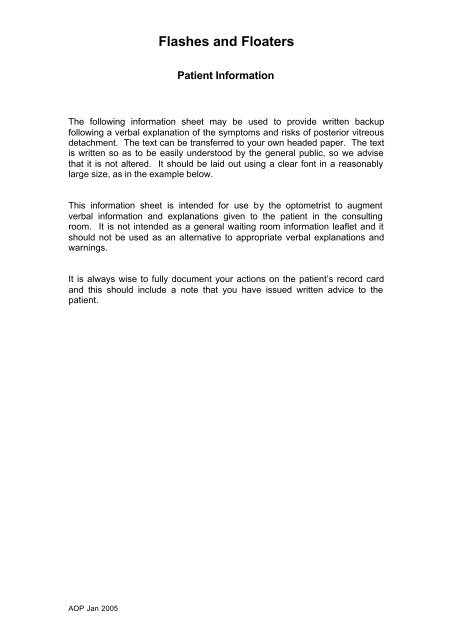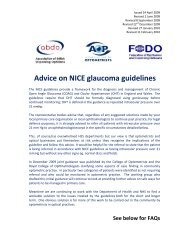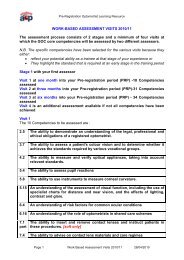Flashes and Floaters
Flashes and Floaters
Flashes and Floaters
Create successful ePaper yourself
Turn your PDF publications into a flip-book with our unique Google optimized e-Paper software.
<strong>Flashes</strong> <strong>and</strong> <strong>Floaters</strong><br />
Patient Information<br />
The following information sheet may be used to provide written backup<br />
following a verbal explanation of the symptoms <strong>and</strong> risks of posterior vitreous<br />
detachment. The text can be transferred to your own headed paper. The text<br />
is written so as to be easily understood by the general public, so we advise<br />
that it is not altered. It should be laid out using a clear font in a reasonably<br />
large size, as in the example below.<br />
This information sheet is intended for use by the optometrist to augment<br />
verbal information <strong>and</strong> explanations given to the patient in the consulting<br />
room. It is not intended as a general waiting room information leaflet <strong>and</strong> it<br />
should not be used as an alternative to appropriate verbal explanations <strong>and</strong><br />
warnings.<br />
It is always wise to fully document your actions on the patient’s record card<br />
<strong>and</strong> this should include a note that you have issued written advice to the<br />
patient.<br />
AOP Jan 2005
<strong>Flashes</strong> <strong>and</strong> <strong>Floaters</strong><br />
Patient Information Sheet<br />
What are floaters?<br />
Often, people who have healthy eyes see floaters. They appear as<br />
spots, lines or cobweb effects, usually when you look at a plain surface<br />
such as a white wall or a clear blue sky. They often appear when the<br />
clear jelly in the main part of your eye gets older.<br />
What are flashes?<br />
Sometimes the jelly in the main part of your eye shrinks a little <strong>and</strong> tugs<br />
on the retina (the light-sensitive layer) at the back of your eye. This can<br />
cause flashes of light at the edge of your vision. These differ from the<br />
disturbance of vi sion that can occur with migraine.<br />
When should I be concerned?<br />
If you suddenly notice a shower of new floaters, or floaters along with<br />
flashes or a dark shadow or “curtain” in your vision, then you should<br />
seek advice urgently. These symptoms can mean that the retina is<br />
tearing. Go to an Accident <strong>and</strong> Emergency Department if necessary.<br />
What will happen if the retina tears?<br />
The retina is at the back of your eye. It receives the images <strong>and</strong> sends<br />
them to the brain. This is one of the things that enable you to see. If the<br />
retina tears, it may come away from the back wall of the eye. This is<br />
called retinal detachment. It can result in partial or complete loss of<br />
vision.<br />
How is retinal detachment treated?<br />
A tear may be treated by using a laser. If treated quickly, you may have<br />
a better chance of full recovery. However, if your retina has become<br />
detached, you will need surgery. The operation may restore most of<br />
your vision but may come too late for a full recovery.<br />
Look out for:<br />
• flashes or floaters getting worse<br />
• a black shadow in your vision<br />
• a sudden cloud of spots<br />
• a curtain or veil over your vision<br />
• any sudden loss of vision.<br />
Go to an Accident <strong>and</strong> Emergency Department without delay<br />
if you notice any of these symptoms.<br />
AOP Jan 2005

















